8 Trees and Shrubs With Showy Fall Fruit
These plants add late-season dazzle to a garden when most plants are winding down
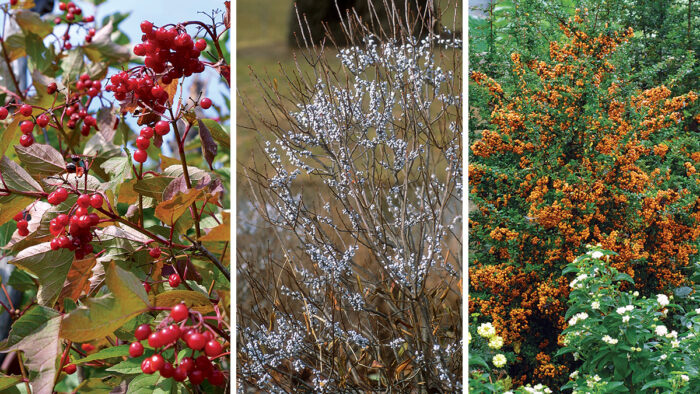
Plants that yell, “Hey, look at me!” can sometimes seem hard to come by in fall and winter. Because most plants are heading into dormancy at this time, flowers and even attractive foliage are typically nonexistent. That’s why I add trees and shrubs with dazzling and dramatic late-season fruit to my designs. Ranging in color from candy apple red to jet black, the ornamental fruit of these plants provides as much color as the spring and summer flowers of many trees and shrubs—and often last much longer. Gardeners are not the only ones who benefit; many resident and migrating songbirds dine on the fruit and disperse their seeds. And although the birds love to eat them, gardeners should refrain. The fruit isn’t toxic, but it doesn’t taste very good.
Plant trees and shrubs with fall fruit where you can view them from a cozy location in your home, especially in areas with inclement weather in fall and winter. In milder climates, place these plants along a garden path or near a patio. Follow the same design strategies used for flowering plants: harmonize or complement the fruit colors with other garden elements or plants.
‘Harvest Gold’ flowering crabapple
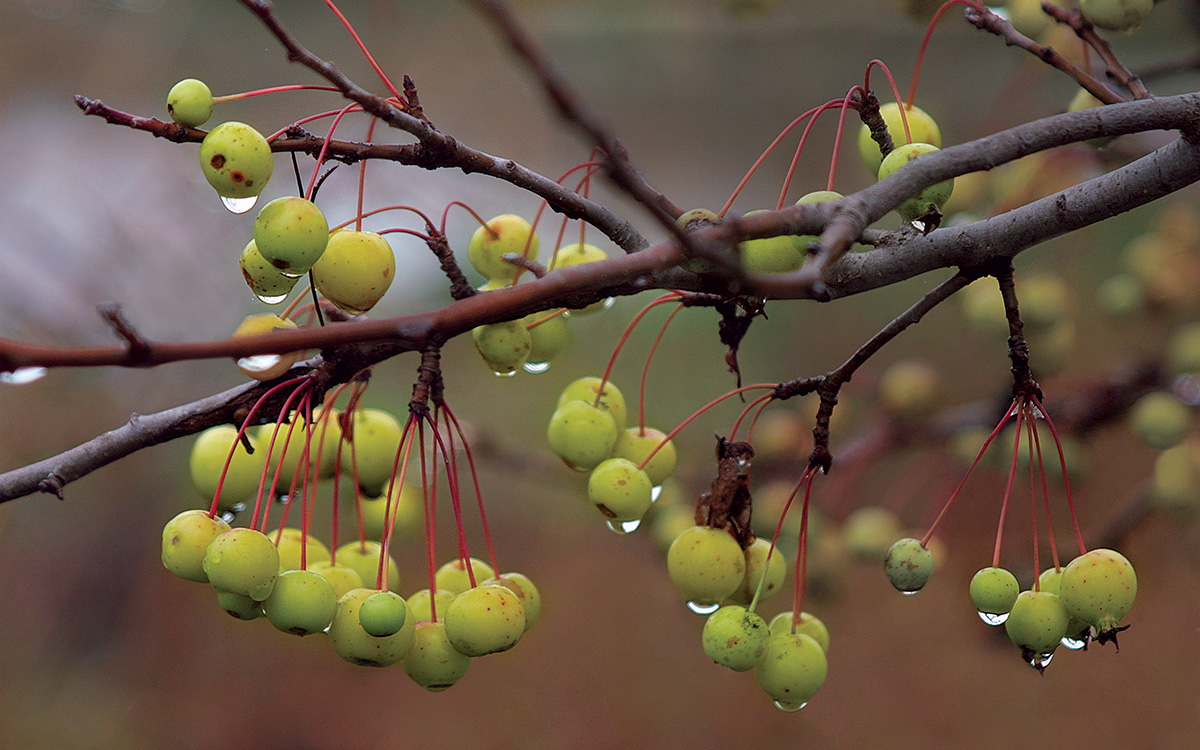
Name: Malus ‘Harvest Gold’
Zones: 4 to 8
Size: 15 to 20 feet tall and wide
Fruit duration: fall
Good for: three-season interest; large landscapes
Crabapples (Malus cvs., Zones 3–9) come in a wide array of fruit colors: burgundy purple, red, orange, green, and—my favorite—yellow. Of the several disease-resistant, yellow-fruiting cultivars, ‘Harvest Gold’ seems to be one of the best. Starting off in midspring with fragrant, red-budded, white flowers, this selection hits the gardening season running.
As the flowers fade, the disease-free foliage emerges. The fruit become the star of the show as they turn a magnificent golden yellow in fall after the foliage drops. The fruit are especially beautiful when enveloped in evening light. They fade to the color of dried apples when fierce cold strikes, but they will remain on the tree until birds clean the branches.
‘Harvest Gold’ has a dense, rounded form and is easy to grow in a wide range of well-drained soils. The tree requires full sun or nearly so to produce the best fruit. It grows rather quickly and probably needs another cultivar of apple or crabapple somewhere nearby to cross-pollinate, which is usually not a problem in most parts of the country.
American cranberry bush viburnum
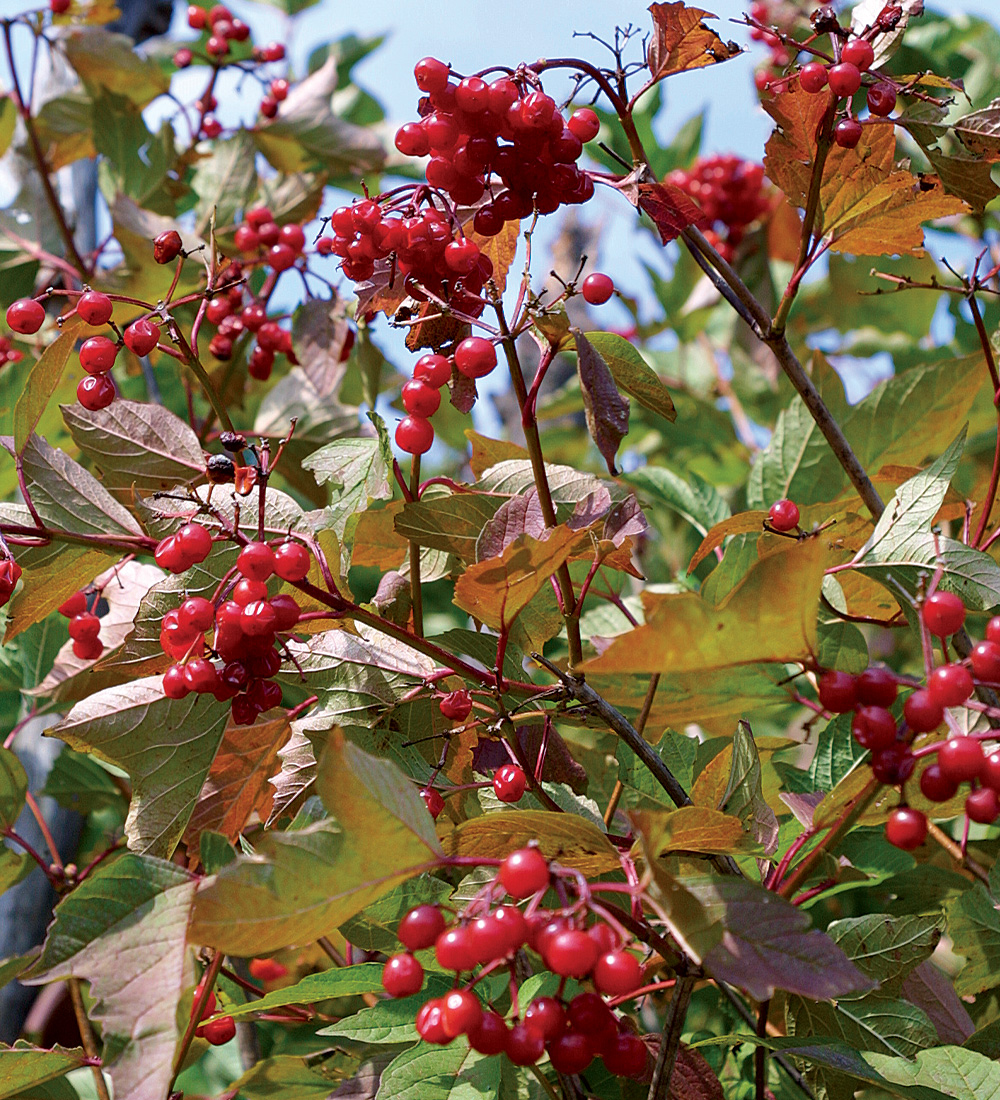
Name: Viburnum trilobum and cvs.
Zones: 2 to 7
Size: 8 to 12 feet tall and wide
Fruit duration: fall and winter
Good for: spring flowers; large landscapes; northern climates
I can think of no other large shrub that provides such brilliant red fruit as the American cranberry bush viburnum (Viburnum trilobum and cvs.). The fruit sparkle in the low light of fall and winter, and are often accentuated by a blanket of snow. The product of striking, white, lacecap flowers set in late spring, the astringent fruit turn to a golden hue in late summer, then take on a red blush before deepening to red in fall. The red contrasts nicely with the shrub’s green, maplelike leaves.
The fruit of this viburnum remain after the leaves have dropped, and hold well into winter without discoloration, even in fierce below-zero temperatures. Plant this shrub outside a window in a spot that receives afternoon shade. Horticulturists have selected more compact forms, but be aware that some dwarf cultivars do not set much fruit. For good fruit set, stick with larger varieties like ‘Wentworth’ and ‘J. N. Select’, which reach 8 to 10 feet tall.
Northern bayberry
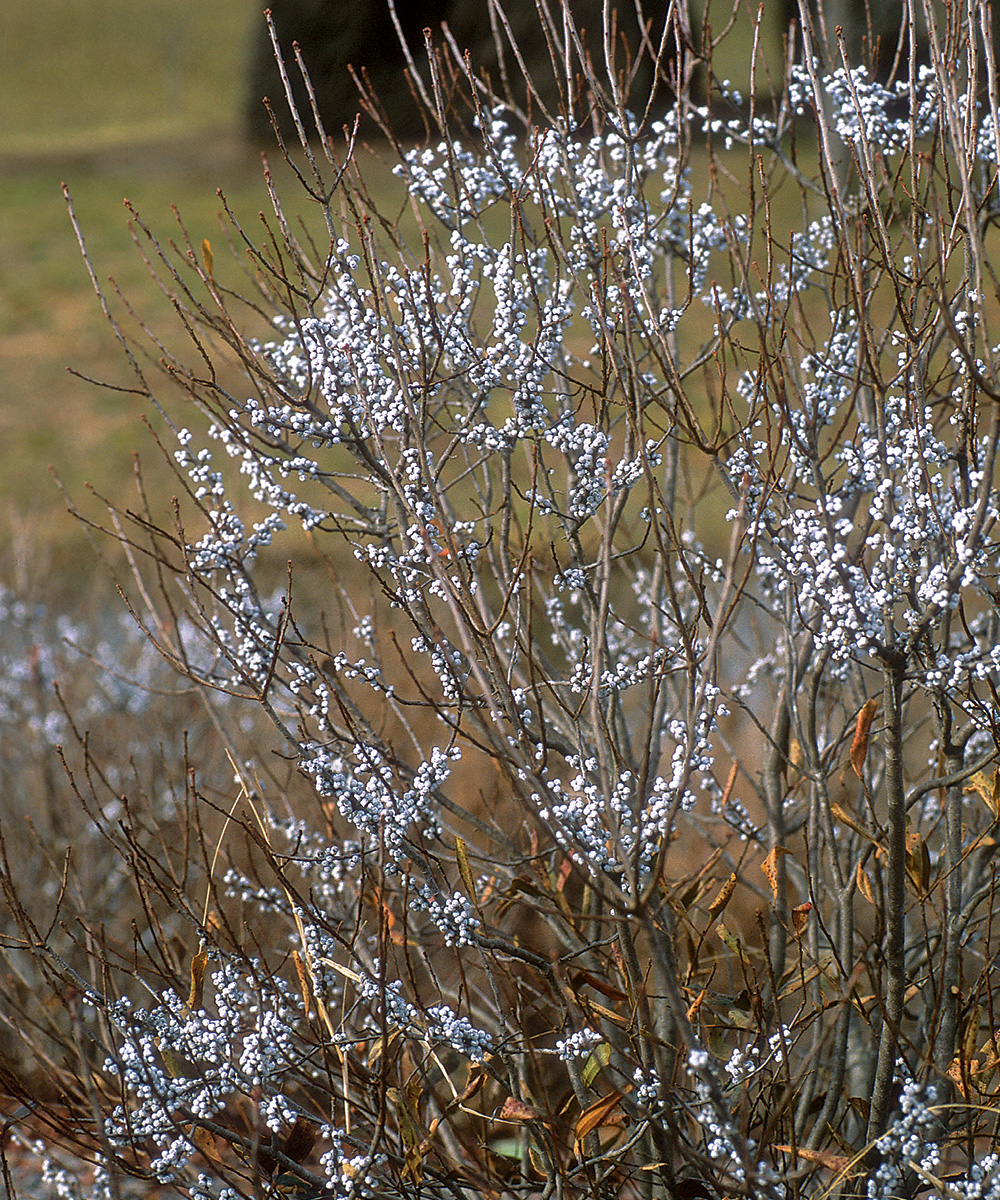
Name: Myrica pensylvanica and cvs.
Zones: 4 to 7
Size: 5 to 12 feet tall and wide
Fruit duration: fall and winter
Good for: naturalizing; seashores; northern climates
One of my favorite fall fruiting plants is the northern bayberry (Myrica pensylvanica and cvs.). A North American native, plants are either male or female (dioecious). The deciduous female plants produce an abundance of ghostly blue-gray berries along their upper and outer stems. The aromatic, waxy fruit persist from early fall until the following spring and appeal to many bird species. Male plants, which are evergreen in mild years, need to be planted near female plants to pollinate the female flowers for good fruit set.
To be sure you have female and male plants, buy shrubs when they are in fruit in fall. Two notable female cultivars are ‘Wildwood’, selected by the U.S. Department of Agriculture, and ‘Morton’, selected by the Morton Arboretum in Chicago. These cultivars are superior garden ornamentals with clean foliage and dense forms; typical female seedlings work just fine, however, in naturalistic plantings. Female bayberries reach only 5 to 6 feet in height, while males grow to 9 to 12 feet. These make exceptional garden workhorses in full sun or partial shade. Perfect for screening and massing, they are fast growers and tolerate poor soils, heat, cold, and drought.
Possumhaw
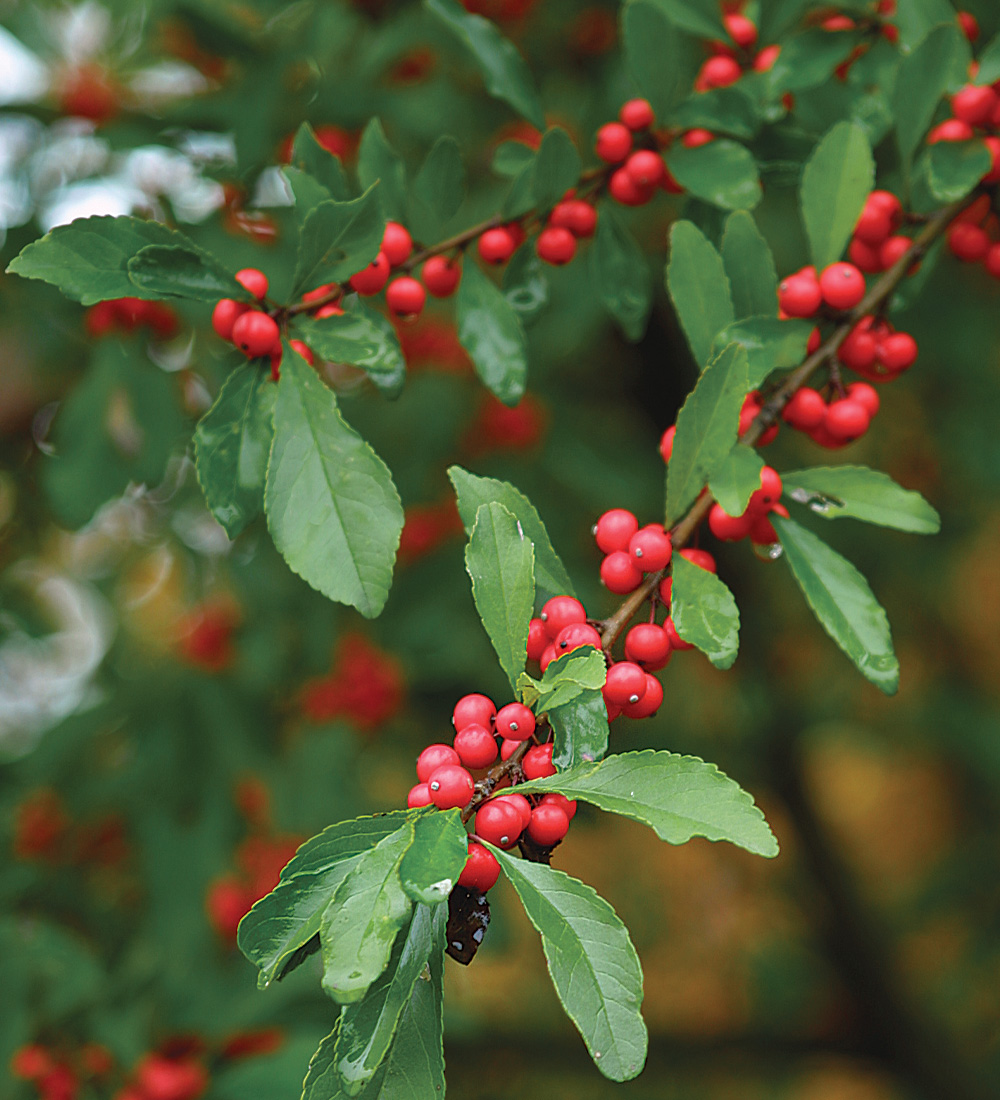
Name: Ilex decidua and cvs.
Zones: 5 to 9
Size: 7 to 20 feet tall and wide
Fruit duration: fall and winter
Good for: large landscapes; southern climates; wet and dry conditions
Although the common name, possumhaw (Ilex decidua and cvs.), doesn’t conjure up visions of grandeur, this small deciduous tree is a knockout in fall through winter. Ablaze with red berries after leaf drop, possumhaw looks like a red-flowering tree. The fruit consistently last longer than those of its smaller and better-known relative, the winterberry (Ilex verticillata and cvs., Zones 5–8), but they can become discolored when the thermometer dips below –10°F. Migrating songbirds sometimes gobble the fruit, an activity that provides hours of birding entertainment through winter.
Only female possumhaw plants bear fruit, and they require a male pollinator nearby. ‘Red Escort’ is an excellent pollinator with glossy, dark green leaves. Female cultivars are worth seeking out, as they tend to have better form, foliage, and fruit than the species. The 20-foot-tall cultivars ‘Warren Red’ and ‘Red Cascade’ have a round habit and bright red fruit, while 15- to 20-foot-tall ‘Pendula’ has pendulous branches adorned with scarlet fruit.
Possumhaw produces an abundance of fruit when given full sun or at least half a day of afternoon sun. It is forgiving of soil types and is heat and drought tolerant once established.
American beautyberry
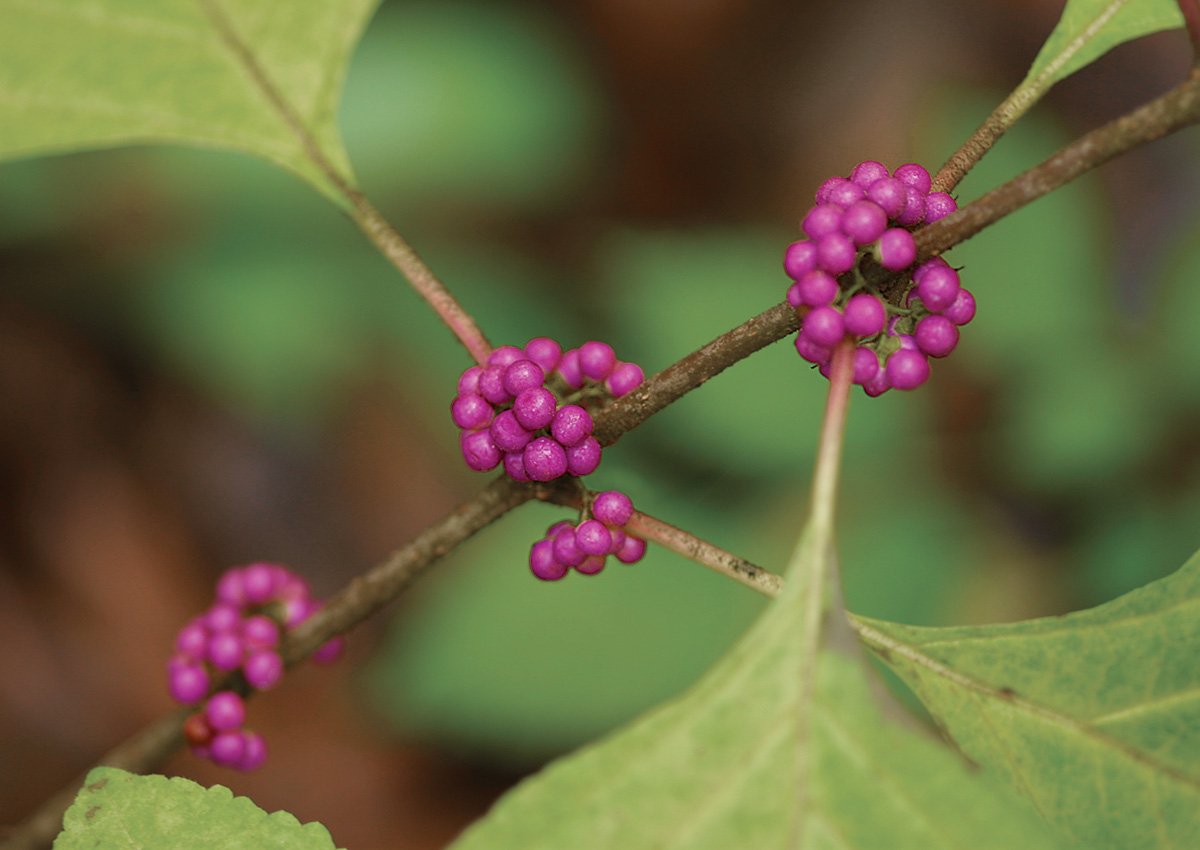
Name: Callicarpa americana
Zones: 5 to 9 (6 to 9 for good fruiting)
Size: 3 to 8 feet tall and wide
Fruit duration: fall
Good for: mixed borders; southern landscapes; humid areas
When I first saw American beautyberry (Callicarpa americana), I was shocked by the brilliant ruby-violet fruit, to which no photograph can do justice. The display lasts longer than that of most flowering plants, carrying on through the fall season. As winter arrives, the fruit will dehydrate and drop—if they are not eaten by wildlife first.
This astonishing shrub grows in full sun to full shade. It can grow upward of 8 feet tall in its native haunts (Virginia to Texas). In northern climates, where it should be planted in full sun, it reaches a modest 3 to 4 feet in height. To keep it more compact, cut it back hard in early spring; its lavender, fruit-producing flowers bloom in summer on new wood.
American beautyberry thrives in the long, hot, and humid summers of the South and will produce fruit only in Zone 6 or warmer. In northern areas with cooler summers, plant the Asian purple beautyberry (Callicarpa dichotoma, Zones 5–8) for a similar fruit effect.
‘Teton’ firethorn
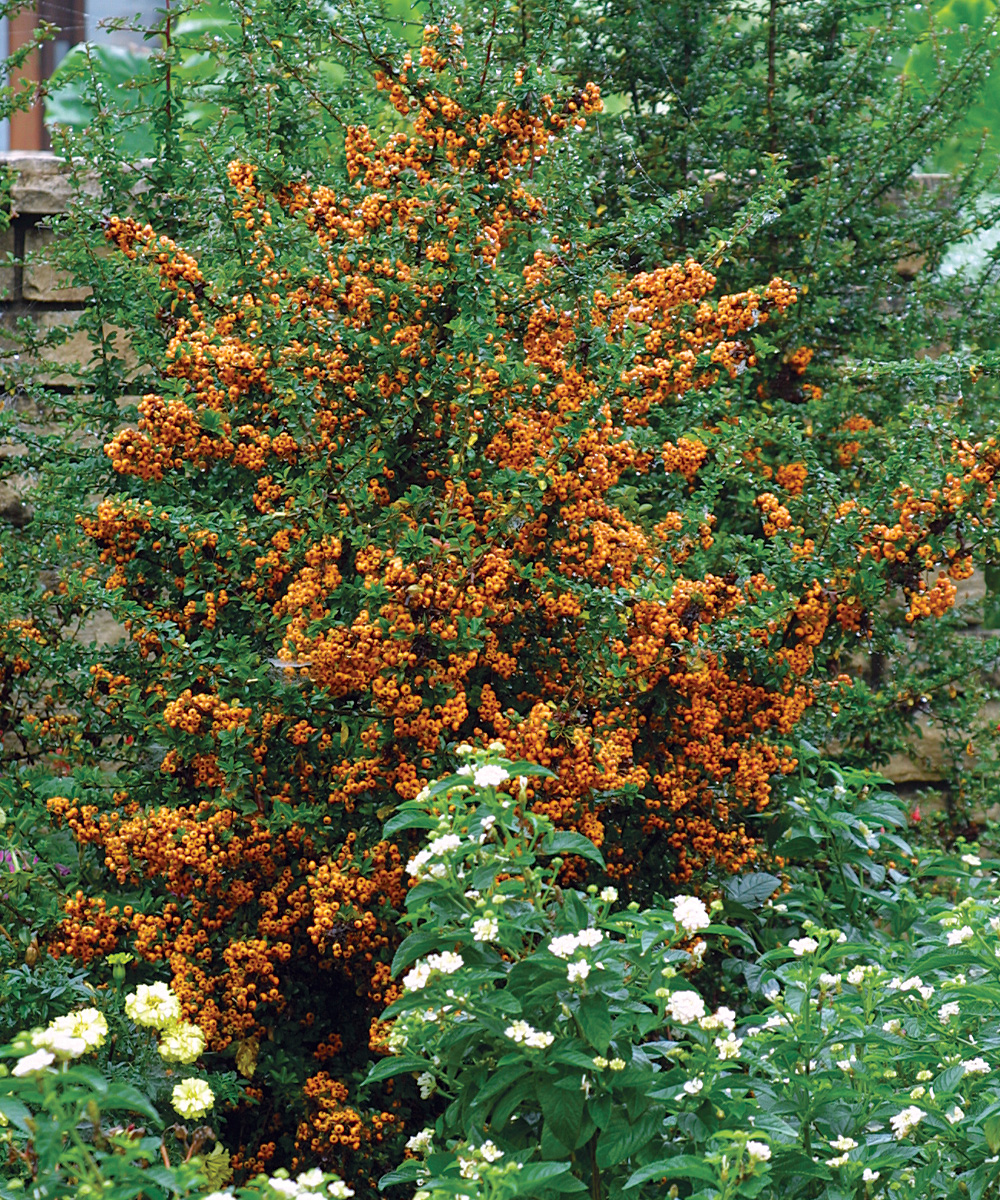
Name: Pyracantha ‘Teton’
Zones: 6 to 9
Size: 10 to 15 feet tall and wide
Fruit duration: fall
Good for: hedges; espalier; areas with dry summers
When asked to name the best ornamental shrub with orange fruit, I immediately think of a firethorn (Pyracantha spp. and cvs., Zones 6–9). The vibrant fruit thickly cover the shrub from top to bottom in fall and remain until winter, when they lose their color and dry up. Birds and other wildlife sometimes eat the fruit.
One of my favorite Pyracantha cultivars is the yellow-orange–fruiting ‘Teton’. It is a great shrub for hedges, screenings, and masses used to control erosion. Like other firethorns, ‘Teton’ is also a beautiful subject for espalier. It has a large, dense form with angular branches that are often tipped with a spine. The foliage is evergreen to semievergreen in harsh winter areas, and fragrant, white flowers adorn plants in late spring.
Firethorns like full sun to partial shade and tolerate a variety of soils as long as they are well drained. ‘Teton’ is an excellent scab- and blight-resistant cultivar. Other selections can be susceptible to these diseases, which cause fruit to drop prematurely. This tends to be more of a problem in areas that experience humid summers and less of a problem for gardeners in the West. When planted in highly exposed sites with good air circulation, plants appear more resistant.
Black chokeberry
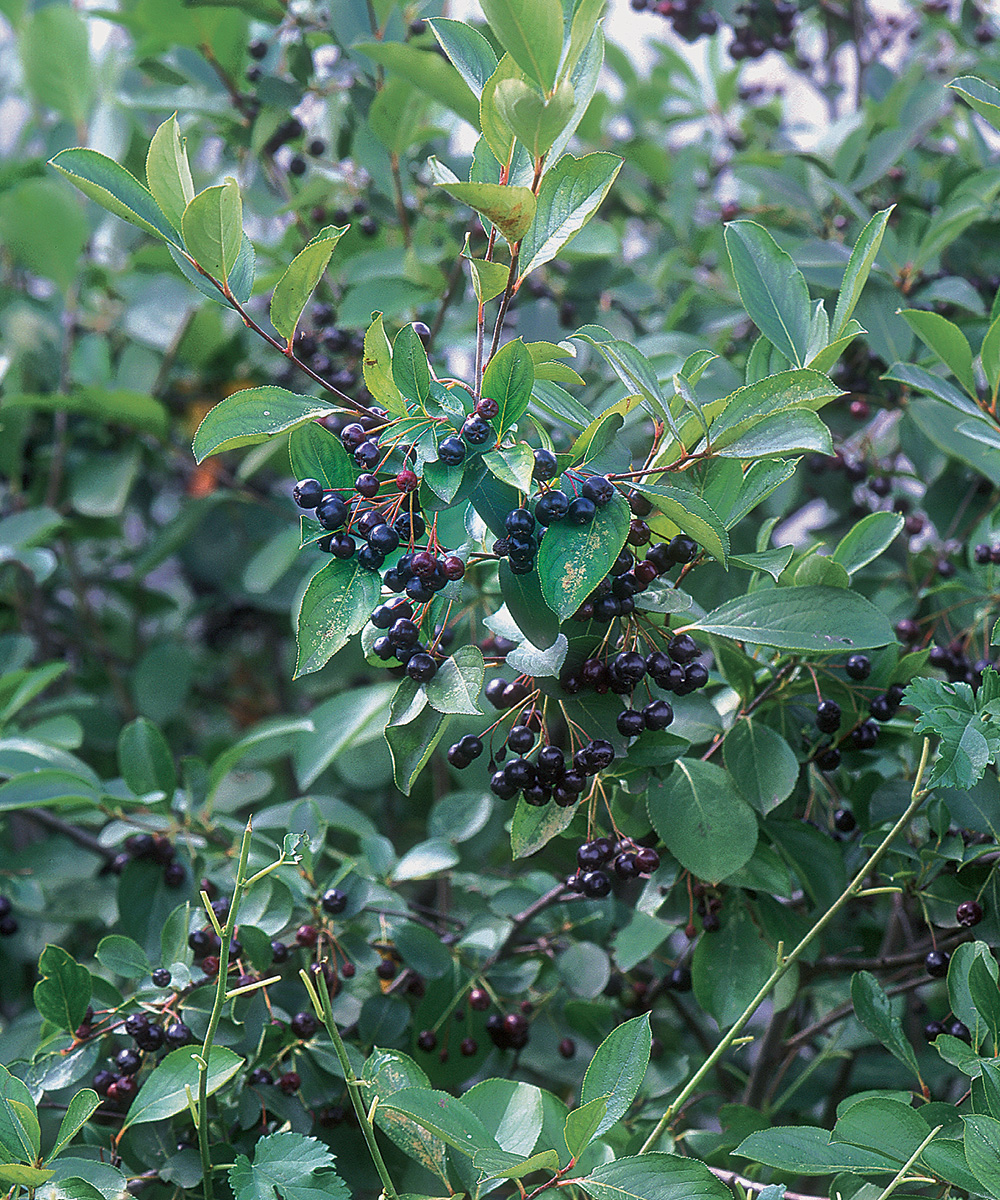
Name: Aronia melanocarpa and cvs.
Zones: 3 to 8
Size: 3 to 5 feet tall and wide
Fruit duration: fall
Good for: small areas; borders and formal plantings; northern climates
The glossy, inky black fruit of black chokeberry (Aronia melanocarpa and cvs.) are a handsome vision in fall. Particularly striking against the shrub’s red fall foliage, the fruit will last beyond leaf drop and seem to go untouched by birds. The fruit are not palatable, except for the cultivars ‘Nero’ and ‘Viking’, which were bred for making juice.
Black chokeberry looks best when massed in borders in either naturalistic or more formal settings. It is a relatively small, deciduous shrub, adapted to a range of soils as long as they are well drained. Black chokeberry produces white flowers in midspring as the foliage is expanding. The leaves are an attractive, glossy, dark green and are unblemished by disease or insects.
The best flower and fruit displays occur in full sun, but plants do fairly well in partial shade. Black chokeberry is an easy-care plant that requires little water once established. It needs no pruning, other than the occasional removal of old stems or wayward branches.
White-fruited nandina
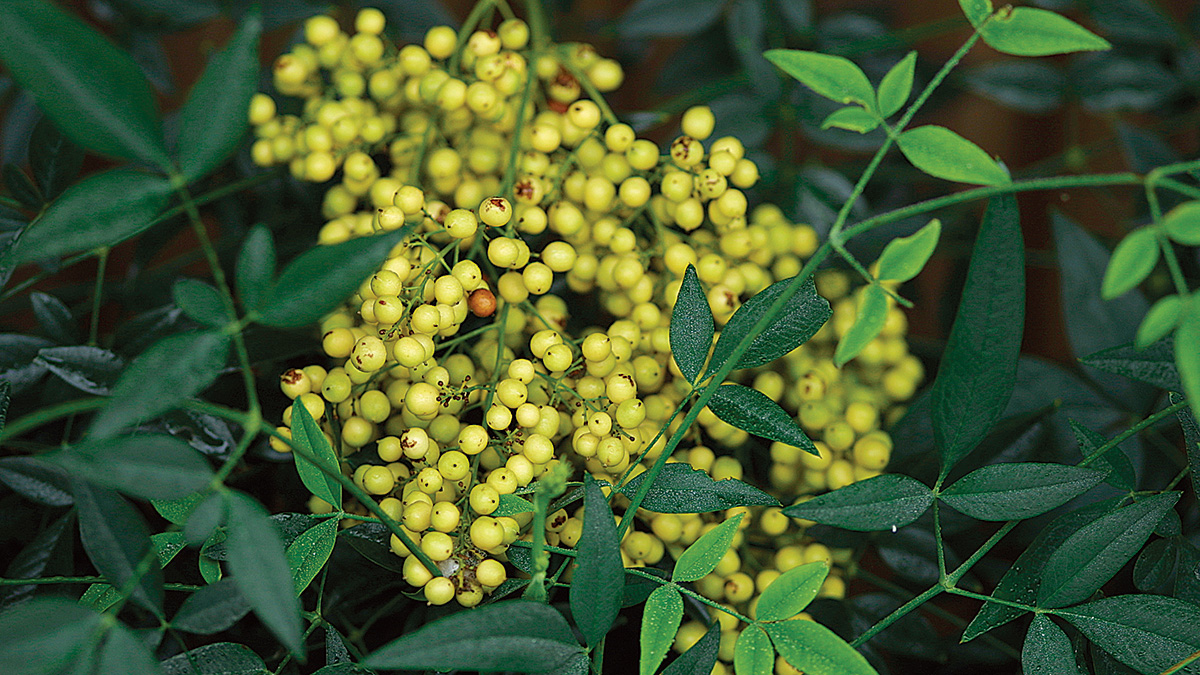
Name: Nandina domestica var. leucocarpa
Zones: 6 to 11
Size: 5 to 6 feet tall and wide
Fruit duration: fall and winter
Good for: foundation plantings; southern climates; dry or humid conditions
White fruit can be hard to come by, so when I first saw white-fruited nandina (Nandina domestica var. leucocarpa, syn. N. domestica ‘Alba’), I knew I had to have it. Also commonly known as heavenly bamboo, this unique shrub from Asia produces ivory or golden white fruit that mingle with the plant’s evergreen compound leaves in the height of autumn. Sometimes eaten by birds, the fruit hang on through winter before dehydrating and turning caramel brown by spring. The foliage remains a lustrous mat of green in winter, when many other nandinas turn shades of burgundy. The shrub tends to sucker and form small thickets of stems but not obnoxiously so.
This shrub is shade tolerant and will grow in low-lighted courtyards and under the overhang of buildings. The white berries add a bright element to dark plantings, but plants also do fine in full sun. Site white-fruited nandina in just about any well-drained soil, and keep it sheltered from wind north of Zone 7. It doesn’t mind dry or humid conditions. It prefers regular rainfall or irrigation but can stand up to drought once established.
For the best effect, place white-fruited nandina and other fall-fruiting shrubs in areas where they’ll be viewed often from indoors and out. Study your garden this fall to find spots where the plants’ wide range of colors will enrich your landscape. Create dynamic scenes by placing these trees and shrubs in locations where their fruit will complement fall-foliage displays, ornamental grasses, and the seed heads of perennials like purple coneflowers (Echinacea purpurea and cvs., Zones 3–9) and black-eyed Susans (Rudbeckia spp. and cvs., Zones 3–9). The result will be an autumn feast for the eyes.
Fine Gardening Recommended Products

Ho-Mi Digger - Korean Triangle Blade
Fine Gardening receives a commission for items purchased through links on this site, including Amazon Associates and other affiliate advertising programs.

DeWalt Variable-Speed Cordless Reciprocating Saw with 6-Piece Saw Blade Set
Fine Gardening receives a commission for items purchased through links on this site, including Amazon Associates and other affiliate advertising programs.
- 18.31 x 6.13 x 4 inches
- 1-1/8-inch stroke length
- Variable speed trigger with 0-3000 spm
- DW4856 Metal/Woodcutting Reciprocating Saw Blade Set, 6-Piece

DeWalt Variable-Speed Cordless Reciprocating Saw
Fine Gardening receives a commission for items purchased through links on this site, including Amazon Associates and other affiliate advertising programs.
- 18.31 x 6.13 x 4 inches
- 1-1/8-inch stroke length
- Variable speed trigger with 0-3000 spm






Comments
marvelous
graceful
fantastic
fabulous
Log in or create an account to post a comment.
Sign up Log in